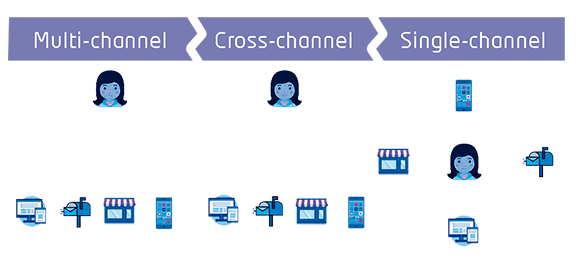There comes a point in every marketing strategy when the communication tools that will carry your messages have been chosen, and you need to decide how they will work together to achieve whatever your ambition is.
Your communication cocktail needs to function as a whole and yet there are three slightly different approaches to get the most from your marketing – we call these distribution options : Multi-channel, Cross-channel or Single-channel.
What is a channel?
A channel is a touchpoint with your customer that serves to distribute your communication messages. To put it simply, your store, your website, your mail and your mobile application are all examples of channels, among a multitude of others. (see list of branding touchpoints)
Most companies have several channels and have the possibility of creating many more. Let’s take a look at the advantages of each of these slightly different approaches to marketing.
Multi-channel strategy
Multi-channelling consists of developing independent communication strategies on different channels. That is to say that you will be active on several channels in parallel to increase your customer base, retain them or simply inform them.
The multi-channel strategy allows you to increase your penetration rate by multiplying the points of contact with your prospects and loyal customers.
Different approaches doesn’t mean no relationship between them. It is easily conceivable that a customer could come into contact with two or more communication actions. This means that your communication strategy must be remain on-brand, whether on mobile, in-shop or on your flyers. Conflicting messages or inconsistent branding will throw customers off and you will quickly lose their trust.
Larger companies often use this strategy but given its excellent penetration rate for a given geographical area there is no reason why a shop could not use this approach locally to increase its notoriety or improve its reputation (example: a new restaurant that has just opened).
Cross-channel strategy
Cross-channel takes the Multi-channel strategy a step further. It is where all your channels are complementary and work in synergy. Unlike the Multi-channel strategy, cross-channel’s goal is focused on increasing your turnover.
Each channel serves the others. A notification on your app should lead to a purchase in your store, the text message you send allows customers to make an online purchase with a promotional code, the game you played on the mobile application offers you a gift voucher to spend in your store, etc…
Cross-channel is about working on several fronts at the same time, although you do not need to use all your distribution channels for this to succeed.
The best example cross-channel is “Click and Collect” which not only reassures and improves the daily lives of consumers, but also increases turnover in stores.
Single-channel strategy
Single-channel increases the tempo. You are everywhere, all the time, at the same time, alternating, never stopping.
People talk about you, you are known as much by word of mouth as by actions of your own initiative. All channels are made available in your strategy to make a link between you and your customers.
In this case you can address your customers with different offers and at the same time on different channels. Your website displays online discounts, your app offers to sponsor a friend to get a discount, and flyers offer discounts on phones to buy-back phones…
This strategy corresponds with the new status of the customer, who has also become single-channel. The customer is now present everywhere, and their buying habits and expectations have changed. You then strive to meet this need by accompanying it on all the channels that you have at your disposal.
Conclusion
There are a multitude of possible brand touch points, and an almost infinite number of ways to use them to distribute your communication messages.
Putting in place Multi, Cross, or Single-channel strategies, will help focus on the aim of your marketing and ease the analysis of their impact.
There is no right or wrong method, but by experimenting on several projects you will discover which approach works better for your company or type of message.
The most important condition when putting them in place is that each channel, at every moment and in every situation, is consistent with your brand image.
If you would like a clearer view of how your channels distribute your communication messages, call Pont Bleu.


Branding Consultant at Pont Bleu Communication
Daren Birchall’s career spans more than 30 years. He is a graphic designer, writer, analyst and communications strategist, marketing consultant, media buyer, production manager, and for quite some time was an advertising agent. He loves photography but his glasses bother him.

